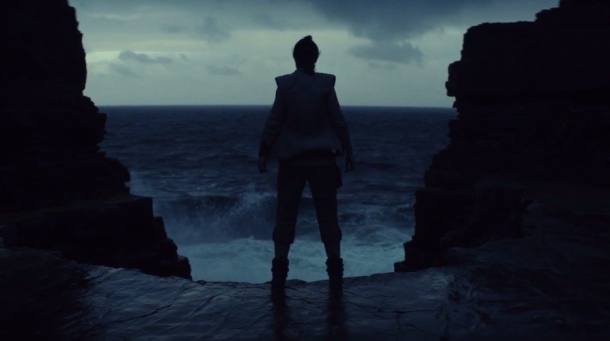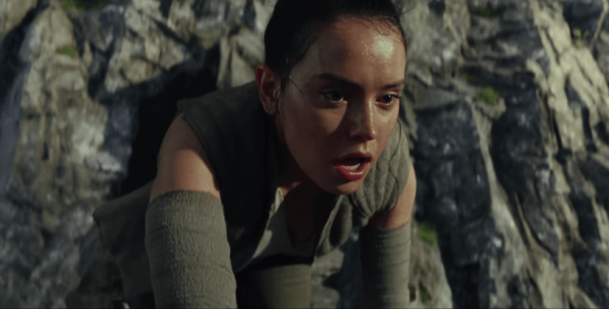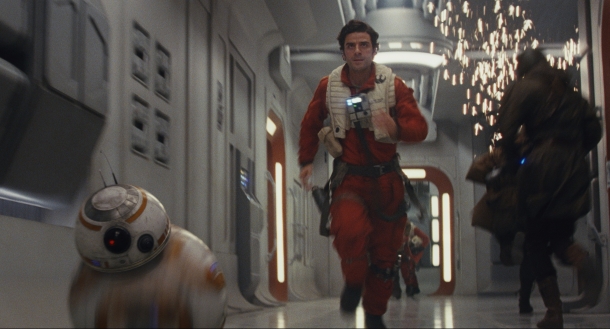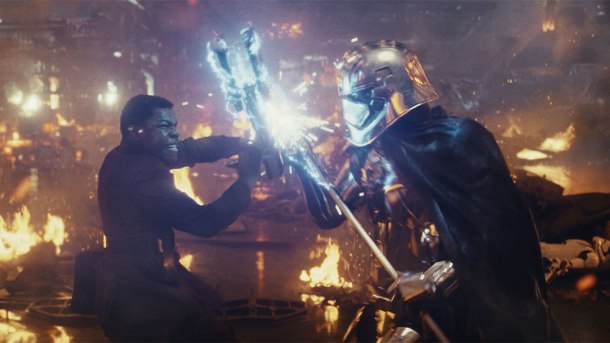by PJ Yerman

(*SPOILERS AHEAD*)
Star Wars: The Last Jedi is the eighth installment in the Skywalker saga, picking up right where 2015’s The Force Awakens left off and sees the return of Luke Skywalker (Mark Hamill) as well as General Leia (Carrie Fisher), Rey (Daisy Ridley), Finn (John Boyega), and Poe Dameron (Oscar Issac) in their ongoing battle against Kylo Ren (Adam Driver) and the evil First Order.
First of all, this movie floored me. Absolutely floored me. There are moments that I totally adored, made my heart swell, my spine tingle, and my tear ducts shimmer, and others that are so misguided and head-scratching that I began to question the Disney-incorporated Star Wars era as it exists today. Therefore, as I foresee a continued complex relationship with the film, this review will serve as a mile-marker (parsec-marker?) for my endless stream of thoughts I’ve accumulated just days after experiencing it. That being said, there’s no way to do that without including SPOILERS. So, fair warning: I’m going to spoil the hell out of this thing.
For The Last Jedi, writer-director Rian Johnson (the only other person besides George Lucas to be credited as such) has crafted an audacious, strange, and shockingly different Star Wars film. It’s one with a uniquely Johnson-esque voice, which carries over from his previous three films, Brick, The Brothers Bloom, and Looper, the latter of which is one of my favorites of all time. When I heard that he would be taking the helm of Episode VIII nearly four years ago, I was nothing but excited, even more so than when I heard about JJ Abrams taking on VII. Ultimately, Johnson has made a film that took as many chances and big swings as it could, which is more than can be said for The Force Awakens. The real question is, did all of these big swings make it past the outfield?
For the most part, they absolutely did. Understandably, The Force Awakens very much needed to feel like Star Wars in order to win back prequel-haters and introduce new fans to the franchise. That’s why so many jumped to deem it a rehash of the original (while I disagree, the we-promise-it’s-not-the-Death-Star Starkiller Base did nothing to dissuade from that argument). Here, though, Johnson throws all those rules out the window. While there are the faintest echoes of The Empire Strikes Back and Return of the Jedi, most of what we see from The Last Jedi has never been seen on-screen in Star Wars before. The former-indie auteur has effectively cracked the franchise open and, after forty years, anything now seems possible. Thankfully, Johnson has proved that there’s merit in breaking things in and scuffing them up a little.
Seeing as Episode VII left us with a literal cliffhanger — Rey offering an outstretched arm holding Luke Skywalker’s lightsaber out to its old owner on a mysterious island clifftop — that sounds like a good place to start talking story. The answer to the two-year-long wait to see how our beloved Jedi Master would react to being reunited with the laser sword he last saw when having his hand lopped off by Dad Vader? He throws it over his shoulder. Like salt on Friday the 13th. Rey is as flabbergasted as the audience.
In a lot of ways, this one action sums up Luke’s character heading into the film. From a story perspective, it makes perfect sense where his head is at. As we learned in The Force Awakens, Luke took a group of students, including Ben Solo (his nephew and Han and Leia’s son), to the first Jedi temple to train a new generation of Jedi. When the mysterious and disfigured Supreme Leader Snoke (Andy Serkis) seduced Ben to the dark side, his new pupil became Kylo Ren and burned the temple to the ground. Disillusioned, Luke exiled himself to the island on Ahch-To, believing now that in order to bring balance to the Force, the Jedi must end. Over the shoulder his lightsaber goes.
The problem here, which is what most hard-core fans are as seeing as a betrayal of Luke’s character, contributing to the downfall of the movie as a whole, is the execution of the scene. John Williams’ swelling score cuts out and the wizened Jedi tosses the hilt with what might as well have been a cartoonish ka-doink. It’s weird. It’s off-putting. But it kind of sums up the ride The Last Jedi is about to take you on. Everything you ever knew about Star Wars is getting thrown over Luke’s shoulder.
Whatever people are criticizing about Luke’s character, it can’t be denied that Mark Hamill is the best he’s been in years. He perfectly plays the balance between wise crotchety old hermit and that whiny, impulsive farm boy the world was introduced to in 1977. For bits of The Force Awakens, it was Harrison Ford that was back on-screen in that jacket with that blaster, not necessarily Han Solo. This is Luke Skywalker, through and through. He’s gained some wisdom, mileage, and self-doubt, and lost a little of his go-get-‘em attitude over the last thirty years, but it’s still Luke Skywalker.

This brings us to Rey. The Luke of this new trilogy, Daisy Ridley brings to life the young former-scavenger who seeks the help of the last Jedi to fight the First Order and, more importantly, learn the ways of the Force and the truth about her parents. In by far the most compelling storyline of the film, Rey and Kylo Ren establish a kind of Force-connection to each other and communicate through simple shot-reverse-shots that link locations that are light years apart by the burgeoning relationship of the two characters. Ridley is just as lovable as she was when we first met her, but here she added levels of tenderness in more emotional scenes and ferocity in the action sequences that make her a delight to watch. She is paired with Luke and Kylo for most of her story and the love/hate triangle that forms between all three of them is attributed to Johnson’s deep understanding of their dynamics. It quickly became clear that this was the story he was most interested in telling. The revelation that Luke thought of killing Ben Solo to stop another Jedi purge, which ultimately led to Ben’s turn to the dark side, adds so many layers to Kylo’s character and to Adam Driver’s performance. Driver continues to deliver breathtaking work as the franchise baddie and I couldn’t help but shake my head in awe during my first viewing, thinking that we get to have acting this good in a Star Wars movie.
One of the best things to come out of The Last Jedi involves Rey and Kylo in one of the most jaw-dropping, bone-chilling, brain-meltingly epic scenes of the series to date. If you’re reading this, then you’ve seen the movie and know what I’m talking about, so I don’t need to over-explain. It involves a lightsaber battle in a throne room that I could watch a hundred times and never tire of marveling at the effortless blend of stunts, camerawork, set design, and character motivation that all culminate to form what might be the perfect action sequence. It felt like Rian Johnson ripped his vintage action figures out of their bubble card packages and played with his toys like a ten-year-old would — with limitless imagination. It was glorious to behold.
The Bantha in the room, when it comes to these particular characters, is how Johnson handled their respective mysteries that Abrams set up for them in The Force Awakens: Who is Snoke? and Who are Rey’s parents? Both, as it turns out, are nobody. Snoke gets bisected by his apprentice before we even find out where he bought his stylish gold robe and after Rey takes an oddly Harry Potter-esque trip through an infinitely-mirrored cave, Kylo spills that her mom and pops were drunken junkers who sold their daughter to buy booze. Upon first experiencing these revelations, I loved them. Rabid fanboys and fangirls (myself included) spent two years endlessly speculating that Snoke was Darth Plagueis or Palpatine or Mace Windu and that Rey’s parents were Luke or Han and Leia or Ben Kenobi. Turns out, none of it was right. It’s a reverse-twist that no one saw coming. The antithesis to “Luke, I am your father.”
While this has some fans up in arms, to Johnson’s credit, he backs up these decisions by making the notion that “nobodies can be somebody” a running theme throughout. The stable boy who casually uses the Force to pick up a broom at the film’s climax solidifies this. The gripe I have is not with the choices made, but the threads that were left dangling during the handoff from Abrams to Johnson. Even though Johnson answered Abrams’ questions (whether you liked them or not), these mysteries are still left unsolved. If Snoke was so unimportant, why did he care so much about finding and destroying Skywalker, the last Jedi? If Rey’s parents were nobodies, why did Rey experience the “Force-back” in The Force Awakens when she touched Luke’s lightsaber if she wasn’t directly related to the events it showed her? I’m fine with audience expectations and the whole “it is your destiny” trope being subverted, but I was disappointed these promising trilogy-spanning storylines were dropped in favor of this single film’s narrative cohesion. It’s a problem I’ve never had with any other movie before and it may be due to what I’ve come to expect from Star Wars. With Episode IX back in Abrams’ hands, we’ll have to wait another two years to see if these threads get tied up and if all this backlash was even worth the energy.
The “B” plots of The Last Jedi, as entertaining and multi-layered as they are, are definitely its weakest parts. The main secondary storyline (there are two), involves cocksure X-wing pilot Poe learning from General Leia to temper his impulse to blow things up while locked in conflict with the Resistance’s acting leader, Vice Admiral Holdo (Laura Dern). The second sees Finn, BB-8, and Rose (new-comer Kelly Marie Tran), a “nobody” maintenance worker, team up with codebreaker DJ (Benicio Del Toro) to take out the First Order’s new, high-tech hyperspace tracker. Yes, all of these things happen in this one movie, and I haven’t even mentioned the third act yet. On paper, it sounds like a mess, and sometimes it is, but Johnson somehow pulls them all together under one banner theme. I’ll get to that a little later.
The stronger of two stories by far is the Poe/Leia/Holdo dynamic. Originally destined to be killed off in The Force Awaken’s first act, Poe wasn’t given a lot to do for the rest of that film besides blow the Starkiller up. Here, his character is arguably the one with the most complete arc, starting off by defying Leia’s orders and taking out the First Order Dreadnaught, despite losing the entire bombing fleet (in a stellar sequence that provokes WWII-like visuals). As a result, he ended up retreating from the final battle in order to keep a spark of hope alive in the galaxy in the form of what’s left of the Resistance. Isaac gives it his all and I can’t wait for Poe to take on a bigger leadership role in the future.

Sadly, though, this will have to be because of the loss of Carrie Fisher, as The Last Jedi marks her final performance as the princess that made her an icon. Leia is given some truly remarkable scenes here and Fisher delivers her best performance in years as well. Feisty and tenacious as ever, Leia felt like Leia, even thirty years on, so much so that one line in particular flashed me back to the original trilogy. When Poe suggests their retreat on the salt planet Crait and everyone looks to Leia to confirm, she deadpans, “What are you looking at me for?” Something about her delivery was just so quintessentially Leia. It’s one of my favorite moments in the film, made even more poignant by the dedication to Fisher in the closing credits, “In Loving Memory of Our Princess, Carrie Fisher”.
Johnson makes another one of his bold choices with the portrayal of Leia’s Force powers, which has been hinted at on screen since Empire but never displayed with any gravitas. I loved the sentiment, and the visceral feeling of seeing it play out on screen for the first time was almost euphoric, especially given Poe and Finn’s gaping-mouthed expressions as they see it play out in front of them. What still hasn’t quite settled with me is the execution of the scene. In one fell swoop, a TIE fighter blows out the bridge of the Resistance’s main ship and all of the high-ranking officials, including the beloved Admiral Ackbar and Leia herself, are sucked into the vacuum of space, and then they cut away to something else. In my head, I said to myself, “Well I guess they really just killed everyone.” It happened so fast and nonchalantly that I couldn’t believe what I had seen. A bit later they cut back and Leia is floating in space and all of a sudden her fingers twitch and she floats like Mary Poppins back to the ship. Weird, right? I appreciated that Leia and Fisher got their big moment, but I’m still not sure where I land on the scene itself.
Also more of a hit-or-miss was Holdo. While I enjoyed Dern’s performance and even didn’t mind her cotton candy hairdo, her character seemed to only be present to provide friction against Poe, stirring up conflict where it wasn’t necessary. Understandably, not all military leaders have the same tactics, but withholding battle strategies seemed like an easy excuse for Poe, Finn, and Rose to go rogue, as opposed to an actual verbal conflict of ideologies. I will say, her death scene might have been the most epic way for any character to go out. In an expert display of sound design and striking imagery, her weaponization of light speed cut through the audience just as much as the First Order ships. You could hear a pin drop in the theater.
Johnson has described this story as a “full plate” and sometimes it feels like there’s food spilling over onto the table. If nowhere else, this applies to the Finn/Rose storyline. Their self-assigned mission to track down a codebreaker in the casino city of Canto Bight was undoubtedly the weakest portion of the film. Boyega is charismatic as ever and Tran comes out of her shell earnestly but their performances weren’t enough to save what felt like an at best distracting, and at worst embarrassing sequence. Del Toro chooses to go full character actor and dons a puzzling stutter. BB-8 is relegated to a sight gag by operating AT-STs and quarreling with prequel flashback-worthy CGI aliens. There’s a jarring message about animal cruelty, despite Chewbacca cooking and almost eating a porg while other porgs watched. Justin Theroux of all people has a head-scratching cameo that took me right out the movie. Captain Phasma (Gwendoline Christie) returns for a possibly even shorter amount time than she had in The Force Awakens, only to get killed off by Finn. All this craziness is spliced in with the other two stories and all it felt like it did was add to the already lengthy runtime. The bits that did feel worth it — DJ influencing Finn as to which side of the fight he should join, and the revelation that war profiteering is connected to both the Resistance and the First Order — got lost in the mess of space horse-riding and lines like “I wish I could put my fist through this whole lousy, beautiful town,” which I assume was written on a day when Johnson had been reading too much Raymond Chandler. If you’re looking for tight story structure, this sequence is telling you to look somewhere else.

Alright, this has been going on for a while now so I’m just going to list the rest of the things I have to say so as not to stretch each one out into their own paragraph: 1) Steve Yedlin’s cinematography is immaculate and I stand by that this is the most beautifully shot Star Wars film yet. 2) The quality of Johnson’s writing cannot be overstated; he understands set-up and payoff like no other filmmaker working today (every word in that sentence was NOT wrong). 3) John Williams delivers yet another brilliant score. My favorite bits were during Leia’s Force float and on Canto Bight. 4) Luke and Kylo’s confrontation on Crait was such a throwback to that old-school Kurosawa samurai shit that I wanted to give Johnson props in the theater right then and there. 5) Fan service is better utilized here than in The Force Awakens. R2-D2 replaying Leia’s old message for Luke reminds him of the adventures of his youth and prompts him to train Rey. 6) This movie lives and dies by its editing and unfortunately the pacing is its downfall. There was so much cross cutting that my actual eyes almost crossed. 7) General Hux (Domhnall Gleeson) goes from a Hitler youth in VII to essentially a punching bag in VIII. 8) Rose kissing Finn after saving him from his own self-sacrifice made absolutely no sense and ruined what could have been a noble end for the former stormtrooper. 9) Some of the comedy worked and some didn’t. The Poe/Hux phone call gag — kind of out-of-place. The “reach out” bit with Luke messing with Rey — funniest part of the movie. BB-8 shooting coins at police officers — should have been left on the cutting room floor. 10) Luke graphically milks the utters of a sea cow and from then on I knew nothing in this movie would be what I thought it’d be.
The last thing I want to touch on is the thematic elements of this film. The through-line that connects all of these stories together is the notion of learning from failure. Luke fails to train Rey. Rey fails to turn Kylo. Kylo fails to destroy the Legend of Luke Skywalker. Finn and Rose fail to disable the hyperspace tracker. Poe fails to overthrow Holdo. The Resistance fails to get the upper hand against the First Order. So many characters die! Everyone fails. The only time anyone acknowledges this is during a wonderful scene with Frank Oz returning to voice and puppet (a real puppet, like from the ‘80s!) everyone’s favorite green, backwards-talking Jedi Master, Yoda. Now a Force Ghost and as wise as he’s ever been, Yoda relays to Luke that “the greatest teacher, failure is.”
Johnson’s number one priority for this film was to challenge these characters like never before. From their failures, they grow as people. As a result, while internally changed, everyone is practically where they were at the start of the film. The problem with failure being the overarching theme is that nothing actually gets accomplished in the story, rendering scenes feeling worthless and cut-able. If you go into the movie for a second, third time, remember that this is first Star Wars film to preference character over story. The originals were age-old tales and character archetypes but in a setting no one had ever seen before, the prequels were spectacle and technology over story, The Force Awakens was a careful mix of old and new. Walking out of the theater for the first time, this film felt like an ending chapter. All of the questions previously posed were answered and the new Rebellion takes off in the Millennium Falcon to light the fire that will burn the First Order down. The story that Johnson left to tell is what happens next for these characters, not necessarily the fate of the galaxy itself, not something you see everyday in a Star Wars movie. Now, looking toward Episode IX, anything is possible.
As you can probably tell, I’m still picking my brain up off the floor after watching The Last Jedi. Rian Johnson went out on a limb and made a Star Wars movie that truly lives up to Kylo’s mantra, “let the past die.” Ultimately, it’s a film with higher highs than The Force Awakens, but also lower lows. We’re in a new age of this franchise now and Johnson has traded in fulfillments of destiny for nobodies who have the potential to be the galaxy’s saviors. Regardless of the endless speculation and fan theories, this is the Episode VIII we got and it’s important not to judge it on what it could have been verses what Johnson has presented us. As Yoda says in his parting words to Luke,“We are what they grow beyond.” Who knows, my opinions could change after another couple dozen viewings, but for now, I’m learning to grow beyond what I thought Star Wars could be.
4.5 out of 5 stars